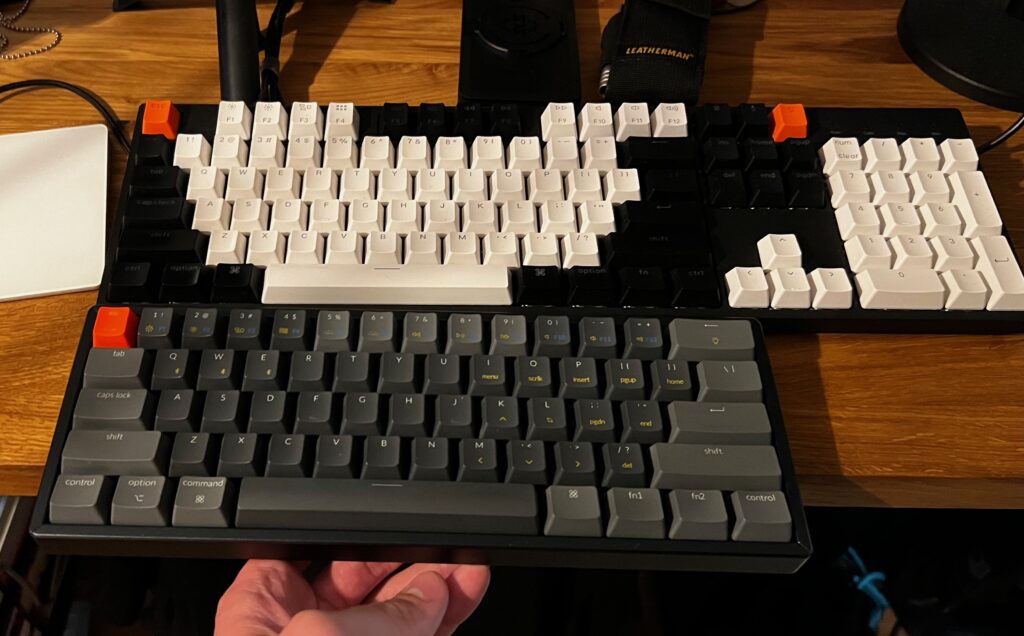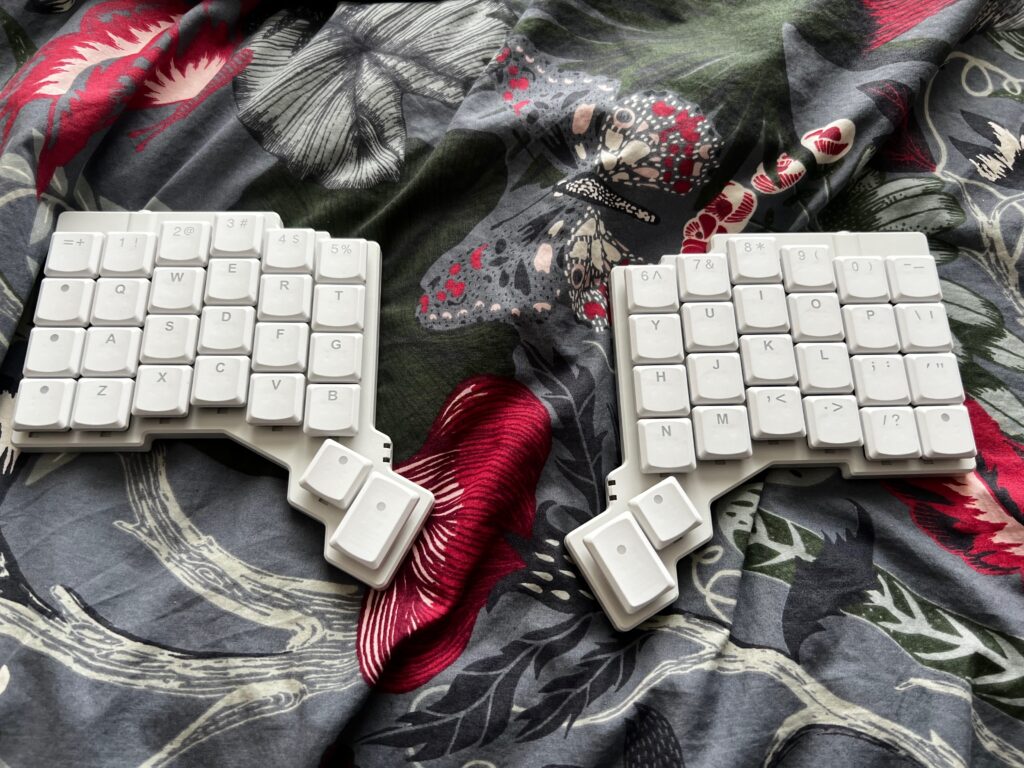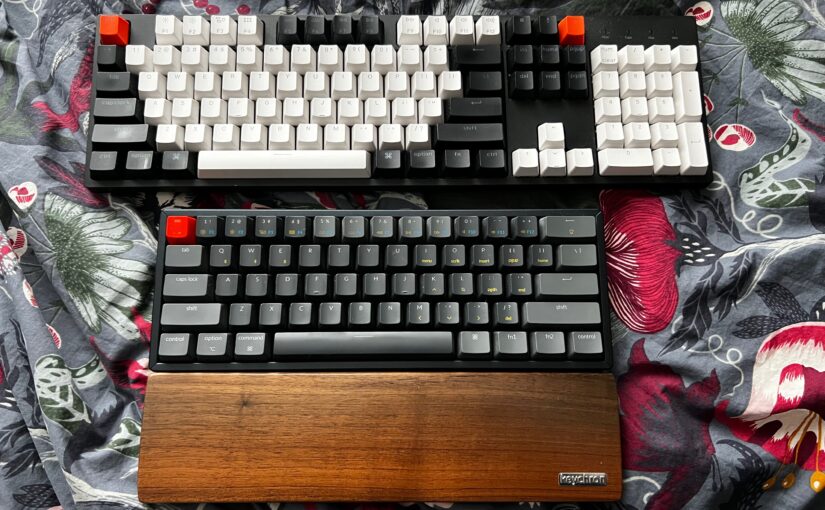All articles in this series:
- Why I switched to the split columnar keyboard
- ZSA Voyager – buying & waiting
- ZSA Voygare – unboxing and the first impressions
A bit of history
Have you ever wondered why every row with letters on a keyboard is moved a bit to the side, but no such thing is happening on the numpad? Do you know how this impacts your ergonomics?

Let me introduce you to the staggered keyboard layout. The staggered layout means that each row of letters is moved a bit to the side. I would bet that 99% of keyboards currently sold or built-in into the devices are staggered keyboards.

Such a layout was introduced with the first typewriters. So the layout that you are currently using has not changed since the 1870s! The idea was simple – there was a mechanical device, and on each key press the ribbon was moved to type a character. To prevent jamming the ribbons the staggered QWERTY layout was introduced. As you might guess, the more the machines become popular, the layout becomes a standard.
Later computers were invented, and they also got a keyboard, yes, with the same QWERTY staggered layout. But you might be wondering – there are no ribbons on the keyboard, so why did we still use the same layout? The answer is pretty simple – the people were already used to the layout from the typewriters, consequently, it was easier to switch to the computer if it had the same layout. OK, now that the history lesson is done, let’s jump to another part of this article.
What is wrong with the staggered layout?
Let’s think about how we usually write on the staggered keyboard.
The device is in front of you, and it is narrower than your arms, hence you have to angle your wrist to type properly. This position is not ergonomic at all. Let’s list all the problems.
Problem one – the keys are not aligned with your fingers. For example, if you want to press key D and then E, you have to move the finger up and a bit left. Yes, you might be already used to that, but would it be better to just move up?
Problem two – angling your wrists. If you do so for many hours, many days per year, this can lead to repetitive strain injuries.
Problem three – closing the chest by angling your arms to the inside. By sitting in such a position for a long time, you will have weaker back muscles. It can also lead to pain in the back/shoulders.
Problem four – many of the keys are out of reach so you have to move your whole hand to reach them. That usually means angling your wrist even more…
My issues
I have been working with keyboards for around 15 years. I’ve tried to improve the comfort and ergonomics of my work.
For a few years, I didn’t bother until my first child was born. After a quick parental leave, I went back to work and I discovered the back pain. That is how my ergo journey began. I’ve tried four office chairs and bought a sit-stand desk.
With the keyboards, I started by buying a 100% mechanical keyboard. I quickly realized how ineffective that keyboard was because of how much I had to move my hands.

Consequently, I bought a 60% keyboard, it was way better. But, there was still one problem that started to become a serious issue.
My left shoulder hurt me just after four hours of working. Some of you might say „Hey you need to exercise and all the problems will be gone”. The problem is that I am already an active person, I am working out.
My physiotherapist said that I have a closed chest and I need to open it, so my shoulders will be inlined, which should fix my pain.
At that moment I decided to try something new – the split columnar keyboard.

The switch
After buying the new keyboard, the switch was fairly easy. The worst was the first week. Then all went smoothly.
The biggest benefit of the new keyboard is that it fixed my pain, literally. I can now sit comfortably for hours, my chest is open and my shoulders are aligned.
I thought that after switching I would have problems with typing on a regular keyboard, which I still have, on my laptop. Happily, that is not true. By learning to type on such a keyboard you are doing it from scratch. That means that you still remember how to type on the staggered keyboard. Your brain will contain two distinct muscle memories. For me, it is not an issue to take a laptop, sit on a couch and type on a built-in keyboard. The only problem is that it is much less comfortable…
Should you also switch?
If you have the same feeling as me – why I am using a staggered keyboard that was invented with the typewriters – do not be shy and go for it.
If you have an RSI – then the split columnar keyboards are the way to go.
If you are curious – you will not regret it.
I have to warn you – it is not an easy switch. You have to learn to type again. So you will have to get out of your comfort zone. You have to slow down to get better.
Next articles about the keyboards
As the next article, I am planning to do a review of my split columnar keyboard – the ZSA Voyager. I will show you the process from ordering, first thoughts, and learning up to my current setup.
Stay tuned.


One thought on “Why I switched to the split columnar keyboard”